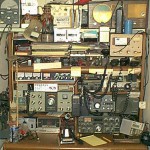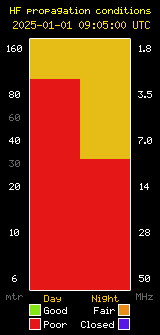 By Darryl Widman, KF6DI – What exactly is Old Timers Night, anyway? Well, let’s say that it is an annual event that occurs at our May SBARC Club Meeting. It is a special time where we can once more meet and greet our “most experienced” amateurs. These folks have paid their dues and come this far along life’s journey to a point where they can boast about having had experiences in the great hobby of Amateur Radio that most of us have only heard about.
By Darryl Widman, KF6DI – What exactly is Old Timers Night, anyway? Well, let’s say that it is an annual event that occurs at our May SBARC Club Meeting. It is a special time where we can once more meet and greet our “most experienced” amateurs. These folks have paid their dues and come this far along life’s journey to a point where they can boast about having had experiences in the great hobby of Amateur Radio that most of us have only heard about.Yes, we did have Amateur Radio in Santa Barbara in the founding years of our hobby. Remember, SBARC was formed way back in May of 1920 — that’s a good 95 years ago! Radio had only been around for about 10 years at that point in time. Was any of you around back then? It is possible that some of you reading this were actually around at that time but I dare say that there are not many.
This special Club meeting gives us youngsters a chance to be in the presence of some Amateur Radio operators who helped form our hobby, back when Spark Gaps were fading into history and AM modulation was first being used. Today we take speaking into a microphone for granted. We also have access to so many other means of communications that, from that ancient perspective, we are dealing with black magic. But it can all be easily explained. It is fascinating and it does work. But I digress.
Our Old Timers look forward to attending this special gathering so that they can stand up and briefly take us down Memory Lane and let us in on what it was like, at least in their shacks, working with quite primitive gear by today‘s standards. They might tell us about how they acquired their basic building materials to put their stations together as few had commercial products available at that time. They might also tell us about how they wound their own coils, fine tuned crystals to their desired frequency by changing their dimensions and even climbed up into tall pine trees to erect fancy antenna systems. What must it have been like without a local Ham Radio Outlet, Amateur Electronic Supply, Juns or even Radio Shack nearby? At Old Timers Night, we have the chance to hear about how these folks did it.
This night also gives us the opportunity to recognize those hams who have been licensed the longest. As a matter of fact, it has become traditional that we have a giant embarrassment ceremony where the President asks everyone in the room to stand and then asks those who have been licensed for 1, 2, 3, 4 or 5 years or less to then sit down, with a pause between each of those numbers. At that point, he asks for those licensed 10 years or less to sit down. This continues along advancing at 5 year increments until we have the king of the evening who remembers when the earth was formed. You don’t want to miss this!
Another fun part of Old Timers Night is where we give our members the opportunity to show off their oldest gear from their stations (whether presently being used or not). We dig through our basements, climb through stuff in our attics and finally, with scraped shins and scratched arms, locate that disgronificator that we used way back when President Hoover gave his inaugural address. Then we bring it to the meeting and display it with duly noted features on paper that we remembered to bring along. And on that same paper, we also tell how and where we used it. It is fun reading about these old marvels. Even if we didn’t actually use this gear in our stations, we still bring old electronic relics and put them on display.
Perhaps you know of an Old Timer who has gotten to a point in his/her life where going out to a club meeting is not possible any more. How about your giving that Old Timer a call and offering a lift to the meeting, or at least arrange a way for him/her to come and be introduced? It would be a distinct honor for members of our Club to meet these fine people who had lived through the earlier days of radio. Do you know someone? I do, and have already made that call.
Remember, Old Timers Night is Friday, May 15. Please come and help honor those who came before us and were a part of Amateur Radio in the past and in some way helped to make the hobby what it is today.
We still have our monthly Club Meetings at the Goleta Union School District at 401 No. Fairview Ave. in Goleta, right across the street from the Goleta Library. The meeting begins at 7:30 PM but come early and look at all the old stuff your old friends have brought for you to see. That is a good time to shake a few hands and bring in those cookies and cakes you brought along because you are a real neat person!
Post expires at 10:00pm on Friday May 15th, 2015 but will still be available in the archives.










